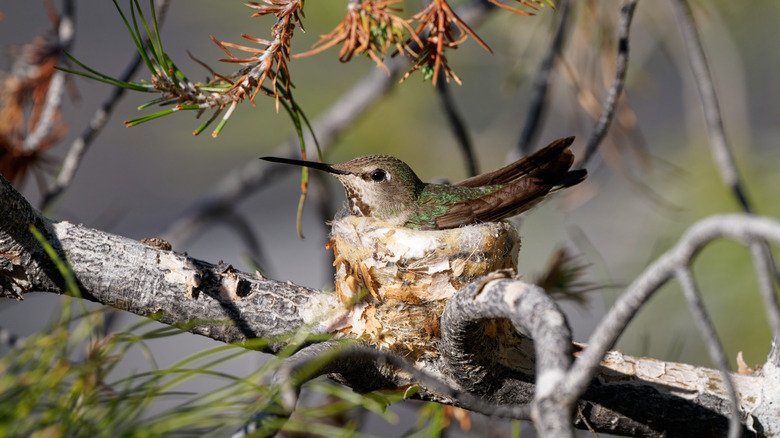Tips For Spotting A Hummingbird's Nest In The Garden (And What To Do Next)
It's every gardener's dream to spot a hummingbird nest tucked somewhere between the branches. With 15 hummingbird species found across the U.S., the chances are better than you might think if you know where to look. However, their nests are almost impossible to spot unless you know what you're looking for. Start by scanning small forked branches, shrubs, or vines just a few feet off the ground.
Hummingbird nests are tiny, often no bigger than a golf ball, and perfectly lined with spider silk, dandelion fluff, and soft natural materials. From a distance, they look like nothing more than a small bump on the branch. Another sign that you've found the nest is if you notice a female hummingbird returning to the same spot again and again, especially after feeding, there's a good chance you've found her hidden nest.
When you are lucky enough to spot a hummingbird nest, admire it from a distance and avoid disturbing the area. During nesting season, which starts in early spring, it's best not to prune trees, shrubs, or vines where nests might be tucked away. These tiny birds may weigh next to nothing, but they have sharp memories. They remember exactly where hummingbird feeders hung, which flowers bloomed, and when to return for the next meal. So, putting off trimming until later in summer gives the chicks time to grow and leave safely.
What to do next after you find a hummingbird's nest
Once you spot a hummingbird nest, the best thing you can do is give it space. According to the U.S. Fish & Wildlife Service, it's illegal to touch or disturb an active nest, so admire from afar. Getting too close can stress out the parent, or worse, cause her to abandon the eggs entirely, and nobody wants to be that person.
Instead, be a helpful neighbor. Keep your feeders full and clean with a sugar-water mix, and to keep the hummingbird feeder safe from ants, use an ant moat or water barrier. The best time of the year to hang a hummingbird feeder is just before spring, so the birds have an easy food source as they settle in. A nearby feeder gives the mother a quick energy boost while she cares for her chicks. Fresh water also helps, whether it's a shallow birdbath, mister, or small fountain.
If you want photos, use a zoom lens or set up a remote camera. No flash, no poking around, and don't hover too long. The less you interrupt, the better. If you absolutely have to get that perfect shot, make sure you're well out of their space and let the camera do the sneaking for you. After all, nothing ruins a family photo like stressing out the family.

